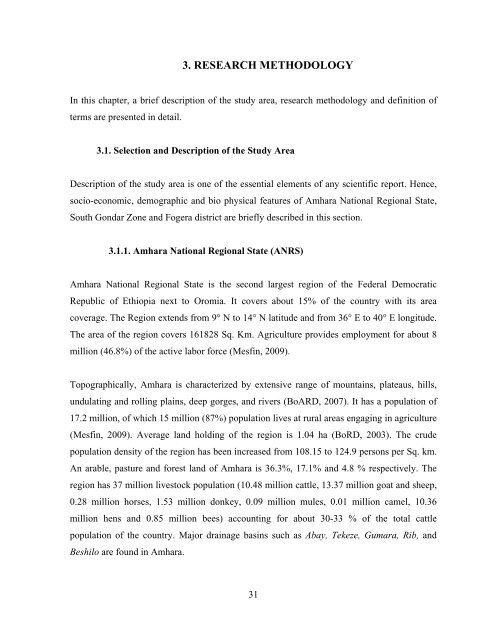effectiveness of modular training at farmers - IPMS Information ...
effectiveness of modular training at farmers - IPMS Information ...
effectiveness of modular training at farmers - IPMS Information ...
Create successful ePaper yourself
Turn your PDF publications into a flip-book with our unique Google optimized e-Paper software.
3. RESEARCH METHODOLOGYIn this chapter, a brief description <strong>of</strong> the study area, research methodology and definition <strong>of</strong>terms are presented in detail.3.1. Selection and Description <strong>of</strong> the Study AreaDescription <strong>of</strong> the study area is one <strong>of</strong> the essential elements <strong>of</strong> any scientific report. Hence,socio-economic, demographic and bio physical fe<strong>at</strong>ures <strong>of</strong> Amhara N<strong>at</strong>ional Regional St<strong>at</strong>e,South Gondar Zone and Fogera district are briefly described in this section.3.1.1. Amhara N<strong>at</strong>ional Regional St<strong>at</strong>e (ANRS)Amhara N<strong>at</strong>ional Regional St<strong>at</strong>e is the second largest region <strong>of</strong> the Federal Democr<strong>at</strong>icRepublic <strong>of</strong> Ethiopia next to Oromia. It covers about 15% <strong>of</strong> the country with its areacoverage. The Region extends from 9° N to 14° N l<strong>at</strong>itude and from 36° E to 40° E longitude.The area <strong>of</strong> the region covers 161828 Sq. Km. Agriculture provides employment for about 8million (46.8%) <strong>of</strong> the active labor force (Mesfin, 2009).Topographically, Amhara is characterized by extensive range <strong>of</strong> mountains, pl<strong>at</strong>eaus, hills,undul<strong>at</strong>ing and rolling plains, deep gorges, and rivers (BoARD, 2007). It has a popul<strong>at</strong>ion <strong>of</strong>17.2 million, <strong>of</strong> which 15 million (87%) popul<strong>at</strong>ion lives <strong>at</strong> rural areas engaging in agriculture(Mesfin, 2009). Average land holding <strong>of</strong> the region is 1.04 ha (BoRD, 2003). The crudepopul<strong>at</strong>ion density <strong>of</strong> the region has been increased from 108.15 to 124.9 persons per Sq. km.An arable, pasture and forest land <strong>of</strong> Amhara is 36.3%, 17.1% and 4.8 % respectively. Theregion has 37 million livestock popul<strong>at</strong>ion (10.48 million c<strong>at</strong>tle, 13.37 million go<strong>at</strong> and sheep,0.28 million horses, 1.53 million donkey, 0.09 million mules, 0.01 million camel, 10.36million hens and 0.85 million bees) accounting for about 30-33 % <strong>of</strong> the total c<strong>at</strong>tlepopul<strong>at</strong>ion <strong>of</strong> the country. Major drainage basins such as Abay, Tekeze, Gumara, Rib, andBeshilo are found in Amhara.31
















